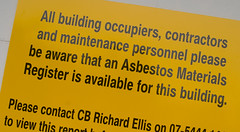The Office of Inspector General of the U.S. Environmental Protection Agency (EPA), in response to allegations that the Agency has authorized the use of unapproved methods to demolish buildings containing asbestos, has issued a warning reiterating previous findings that “asbestos is a human carcinogen with no safe level of exposure.” Inspector General Arthur A. Elkins Jr. adds, “Asbestos exposure can lead to serious diseases such as asbestosis, lung cancer, and mesothelioma.”
Mesothelioma and other respiratory diseases result when asbestos is improperly managed. When asbestos fibers and dust become airborne they can put pedestrians and residents occupying areas near a demolition project at high risk of contracting a deadly, asbestos-related illnesses. For that reason, experienced and certified contractors should always be hired to carry-out any asbestos abatement projects.
The EPA in 1974 issued asbestos management standards to protect human health from the adverse effects of exposure to asbestos, particularly when demolition of buildings is removing asbestos. These standards demand that special trained technicians remove materials that contain asbestos prior to demolition except when a building is structurally unsafe to enter. This is to mitigate the possibility that asbestos material will become dust particles being airborne and breathed by humans. Inhalation of asbestos particles causes mesothelioma cancer 20 to 50 years after exposure.
But according to the recent December 2011 report, even the EPA has not complied with the guidelines it produced in 1974. The EPA has allowed unapproved asbestos removal methods to be used or considered at multiple demolition sites. These construction sites including the Hanford Superfund Site (near Richland, Washington) and a gaseous diffusion plant in Paducah, Kentucky are examples of two locations where questionable removal methods have been used, or are proposed to be used.
The EPA report states:
The current and proposed use of unapproved methods may jeopardize the health and safety of the public.
EPA Inspector General, Mr. Elkins says:
The use of unapproved methods is counter to EPA regulations, and the EPA should retract any approval for the use of alternative asbestos removal methods that deviate from the recognized standards.
Why? Because asbestos is the only known cause of mesothelioma, a disease that kills between 2,500 and 3,000 people in the U.S. each year. Symptoms of mesothelioma, such as shortness of breath and chest pains, may take as many as 20 to 50 years to develop which is frequently a stage three or later. Once diagnosed, mesothelioma progresses rapidly.
The Mesothelioma Research Foundation of America was founded in 2001 with a mission: fund research that leads to the quickest and surest cure for mesothelioma. Mesothelioma is a cancer of the lining of the lungs caused by asbestos exposure. This cancer disease had few treatment options until this MesoRFA.org and Dr. Parkash Gill’s work created better treatment options. Today, the future looks more hopeful for additional improved treatment options available to those stricken by this cancer.
Submit your mesothelioma questions to Ask Dr. Parkash Gill to receive the oncologist’s Free response and opinion.



